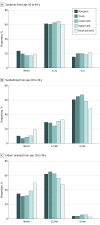Association of Phenotypic Characteristics and UV Radiation Exposure With Risk of Melanoma on Different Body Sites
- PMID: 30477003
- PMCID: PMC6439571
- DOI: 10.1001/jamadermatol.2018.3964
Association of Phenotypic Characteristics and UV Radiation Exposure With Risk of Melanoma on Different Body Sites
Abstract
Importance: Two pathways have been hypothesized for the development of cutaneous melanoma: one typically affects the head and neck, a site with chronic sun damage, and the other affects the trunk, which is less exposed to the sun. However, the possible cause of limb melanomas is less studied under this hypothesis.
Objective: To investigate the association between phenotypic characteristics, pattern of UV radiation exposure, and risk of melanoma on different body sites.
Design, setting, and participants: This study used data on 161 540 women with information on phenotypic characteristics and UV radiation exposure who were part of the Norwegian Women and Cancer study, a population-based prospective study established in 1991 with exposure information collected by questionnaires at baseline and every 4 to 6 years during follow-up through 2015. Data analysis was performed from October 2017 through May 2018.
Exposures: Participants reported hair color, eye color, untanned skin color, number of small symmetric and large asymmetric nevi, and freckling, as well as histories of sunburns, sunbathing vacations, and indoor tanning in childhood, adolescence, and adulthood.
Main outcomes and measures: The Norwegian Women and Cancer study was linked to the Cancer Registry of Norway for data on cancer diagnosis and date of death or emigration. Primary melanoma site was categorized as head and neck, trunk, upper limbs, and lower limbs.
Results: During follow-up of the 161 540 women in the study (mean age at study entry, 50 years [range, 34-70 years]; mean age at diagnosis, 60 years [range, 34-87 years]), 1374 incident cases of melanoma were diagnosed. Having large asymmetric nevi was a significant risk factor for all sites and was strongest for the lower limbs (relative risk [RR], 3.38; 95% CI, 2.62-4.38) and weakest for the upper limbs (RR, 1.96; 95% CI, 1.22-3.17; P = .02 for heterogeneity). Mean lifetime number of sunbathing vacations was significantly associated with risk of trunk melanomas (RR, 1.14; 95% CI, 1.07-1.22) and lower limb melanomas (RR, 1.12; 95% CI, 1.05-1.19) but not upper limb melanomas (RR, 0.98; 95% CI, 0.88-1.09) and head and neck melanomas (RR, 0.87; 95% CI, 0.73-1.04; P = .006 for heterogeneity). Indoor tanning was associated only with trunk melanomas (RR for the highest tertile, 1.49; 95% CI, 1.16-1.92) and lower limb melanomas (RR for the highest tertile, 1.33; 95% CI, 1.00-1.76; P = .002 for heterogeneity). Skin color, hair color, small symmetric nevi, and history of sunburns were associated with risk of melanoma on all sites.
Conclusions and relevance: These results appear to support the hypothesis of divergent pathways to melanoma and that recreational sun exposure and indoor tanning are associated with melanoma on the lower limbs, the most common site of melanoma in women. These findings appear to have important preventive implications.
Conflict of interest statement
Figures
Similar articles
-
Phenotypic and genotypic risk factors for invasive melanoma by sex and body site.Br J Dermatol. 2024 Nov 18;191(6):914-923. doi: 10.1093/bjd/ljae297. Br J Dermatol. 2024. PMID: 39026389
-
Association of Lifetime Indoor Tanning and Subsequent Risk of Cutaneous Squamous Cell Carcinoma.JAMA Dermatol. 2019 Dec 1;155(12):1350-1357. doi: 10.1001/jamadermatol.2019.2681. JAMA Dermatol. 2019. PMID: 31577329 Free PMC article.
-
A prospective study of pigmentation, sun exposure, and risk of cutaneous malignant melanoma in women.J Natl Cancer Inst. 2003 Oct 15;95(20):1530-8. doi: 10.1093/jnci/djg075. J Natl Cancer Inst. 2003. PMID: 14559875
-
Ultraviolet radiation.Chronic Dis Can. 2010;29 Suppl 1:51-68. Chronic Dis Can. 2010. PMID: 21199599 Review.
-
[The sun and malignant melanoma].Hautarzt. 1992 May;43(5):251-7. Hautarzt. 1992. PMID: 1612913 Review. German.
Cited by
-
Adjuvant PD-1 Checkpoint Inhibition in Early Cutaneous Melanoma: Immunological Mode of Action and the Role of Ultraviolet Radiation.Cancers (Basel). 2024 Apr 11;16(8):1461. doi: 10.3390/cancers16081461. Cancers (Basel). 2024. PMID: 38672543 Free PMC article. Review.
-
Indoor Tanning and the Risk of Overall and Early-Onset Melanoma and Non-Melanoma Skin Cancer: Systematic Review and Meta-Analysis.Cancers (Basel). 2021 Nov 25;13(23):5940. doi: 10.3390/cancers13235940. Cancers (Basel). 2021. PMID: 34885049 Free PMC article. Review.
-
Comparative study of cutaneous malignant melanoma according to anatomical site: plantar versus non-plantar melanoma.Arch Dermatol Res. 2024 Nov 20;317(1):35. doi: 10.1007/s00403-024-03523-x. Arch Dermatol Res. 2024. PMID: 39565418
-
Effect of patient-contextual skin images in human- and artificial intelligence-based diagnosis of melanoma: Results from the 2020 SIIM-ISIC melanoma classification challenge.J Eur Acad Dermatol Venereol. 2025 Aug;39(8):1489-1499. doi: 10.1111/jdv.20479. Epub 2024 Dec 8. J Eur Acad Dermatol Venereol. 2025. PMID: 39648687
-
Integrated Analysis Reveals COL4A3 as a Novel Diagnostic and Therapeutic Target in UV-Related Skin Cutaneous Melanoma.Clin Cosmet Investig Dermatol. 2024 Jun 17;17:1429-1446. doi: 10.2147/CCID.S461959. eCollection 2024. Clin Cosmet Investig Dermatol. 2024. PMID: 38911338 Free PMC article.
References
-
- Lucas R, McMichael T, Smith W, Armstrong BK, Prüss-Üstün A. Solar ultraviolet radiation: global burden of disease from solar ultraviolet radiation. World Health Organization IV Series: environmental burden of disease series; no 13. Geneva, Switzerland: World Health Organization; 2006.
Publication types
MeSH terms
LinkOut - more resources
Full Text Sources
Medical


